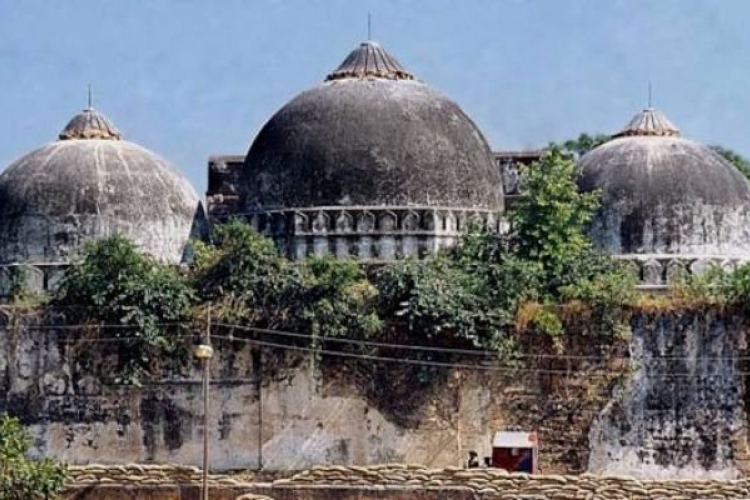All about Ayodhya Issue
The dispute predating to brits in India revolves around a plot of land measuring 2.77 acres in the city of Ayodhya in Uttar Pradesh along the banks of the river Saryu, which houses the Babri mosque and Ram Janmabhoomi. Hindus revere the site as they believe it's the birthplace of Lord Ram while Muslims argue that the land is home to the Babri mosque.
The Ayodhya dispute, putting it simply, revolves around this question: was the mosque built on top of an existing Ram temple – after Mughal invaders 'demolished' it in the 16th century?
Muslims, on the other hand, say that the Babri Masjid was built by Mir Baqi in 1528–29 CE (935 AH) and that Hindus had started idol worship there only after some people desecrated it in 1949 AD, after secretly placing idols of Lord Ram inside the mosque, in the dark. Since the mosque was built on orders of the Mughal emperor Babur, it was named Babri Masjid.
The mosque was demolished by Hindu Karsevaks on December 6, 1992, in Ayodhya. The country witnessed massive riots in which over 2000 people were killed
Following this, the Allahabad High Court in 2010 ruled saying that 'the world knew it was Lord Ram's birthplace', and that the disputed spot was first the deity's birthsite, and that the mosque which came after the temple, was not built in accordance with the tenets of Islam.
The next year, the apex court overruled the HC's judgement, saying it was a 'leap of faith'.
Until today, the issue rages on with Hindus demanding the construction of a Ram temple on the site, with Muslims seeking reconstruction of the demolished mosque.
Timeline of India’s Jerusalem:
1853:Nirmohi Akhara members forcefully occupy the Babri Masjid saying it was Ram Janmabhoomi (Birth place of Lord Ram). Communal riots erupt and last for two years, in the first recorded incident of violence over the holy site.
Boundary wall built for Hindu-Muslims
1855: To avoid further disputes, a boundary wall is constructed to divide the mosque premises into two courtyards; the Muslims offered prayers in the inner courtyard. The Hindus offered their prayers on a raised platform, known as "Ram Chabutara", in the outer courtyard. The Chabutra is a raised platform about a 100 paces away from the mosque proper.”
1934: Walls around the Masjid and one the domes are damaged in the communal riots. The British help in the reconstruction.
Another player enters the agitation
1946: A branch of the Hindu Mahasabha called Akhil Bharatiya Ramayana Mahasabha (ABRM) starts an agitation for the occupation of the site.
1949: The government declares the mosque a disputed area and locks its gates for forty years after the idols of Ram and Sita are planted on the site in the dark.
1959: The Nirmohi Akhara files another lawsuit demanding possession of the mosque.
1961: The Sunni Central Waqf Board also files a lawsuit, demanding possession of the site and removal of idols from the mosque premises.
1984: The Vishwa Hindu Parishad (VHP) launches an enormous movement for the opening of the locks of the mosque.
1986: District judge orders locks be removed. Site opened for Hindu worshippers. A Babri Masjid Action Committee is created as Muslims protest the move to grant Hindu prayers at the site.
1991: The Uttar Pradesh Government acquires 2.77 acre land in the area and gives it on lease to Ram Janmabhoomi Nyas Trust. The Allahabad High Court stops all permanent construction activity in the area.
Babri mosque is demolished
1992: On December 6, Babri Masjid is demolished by a frenzied mob of karsevaks, in which an estimated 2,000 people were killed.
Prime Minister P V Narasimha Rao's government dismisses BJP governments in UP, MP, Rajasthan and Himachal Pradesh.
On 16 December, the government establishes the Liberhan Commission of India to investigate the demolition of the Babri Mosque. Report finds many BJP leaders culpable including Atal Bihari Vajpayee, LK Advani, Murli Manohar Joshi, Kalyan Singh, Pramod Mahajan, Uma Bharti and Vijayaraje Scindia, as well as VHP leaders like Giriraj Kishore and Ashok Singhal.
1993: The Government takes over 67 acres of land around the area, seeks Supreme Court's opinion on whether there existed a Hindu place of worship before the structure was built.
2001: On May 4, Special Judge S.K.Shukla drops conspiracy charge against 13 accused, including senior BJP leaders Advani and Kalyan Singh.
Godhra riots
2002: More than 50 people died in February when a train carrying Hindu Karsevaks returning to Gujarat from the Babri Masjid site is set alight, allegedly by a Muslim mob. At least 1,000 people mainly Muslims died in the violence that ensued,
2010: On September 30, Allahabad HC divides Ayodhya site: one-third going to the Ram Lalla, for the construction of the Ram temple; one-third going to the Islamic Sunni Waqf Board and the remaining to Nirmohi Akhara.
The ruling states that the 'disputed land was Ram's birthplace', that the 'mosque was built after the demolition of a temple' and that 'it was not built in accordance with the tenets of Islam'.
2011: In February, CBI moves Supreme Court. Argues that 'the actual demolition of the Babri Masjid and the continuous assault on media persons form a single connected transaction and can well be a concerted conspiracy.'
2011: On May 9, Supreme Court suspended the Allahabad High Court's verdict on Ayodhya dispute.
March 6, 2017: The Supreme Court indicates it may revive conspiracy charge and order a joint trial of crimes
2017: On March 21, Chief Justice of India J. S. Kehar advised the rival parties to initiate an out-of-court peace negotiations and offered mediation.
2017: On April 19, the Supreme Court revived conspiracy charges against L.K. Advani, Murli Manohar Joshi and 13 others in Babri Masjid demolition cases.
2017: On May 30, BJP veterans L. K. Advani, Murli Manohar Joshi and other accused are granted bail by a special CBI court in Lucknow. However, the court rejected the discharge petition and said charges would be framed against them.
July 20, 2018
The court concluded a series of arguments on the pleas challenging the 1994 verdict that mosque was not integral to Islam and to refer the Ayodhya dispute to a larger Constitution bench. The bench reserves verdict.
September 27, 2018
The Supreme Court declined to refer to a five-judge Constitution bench the issue of reconsideration of the observations in its 1994 judgement that a mosque was not integral to Islam which had arisen during the hearing of Ayodhya land dispute.
October 29, 2018
The SC had fixed the matter in the first week of January before an "appropriate bench", refusing a plea for urgent hearing on the matter.


 IAS-2026 - OPTIONAL / GEOGRAPHY / PUBLIC ADMINISTRATION / SOCIOLOGY / ANTHROPOLOGY / ORIENTATION ON 03 & 04-10-2025
IAS-2026 - OPTIONAL / GEOGRAPHY / PUBLIC ADMINISTRATION / SOCIOLOGY / ANTHROPOLOGY / ORIENTATION ON 03 & 04-10-2025 